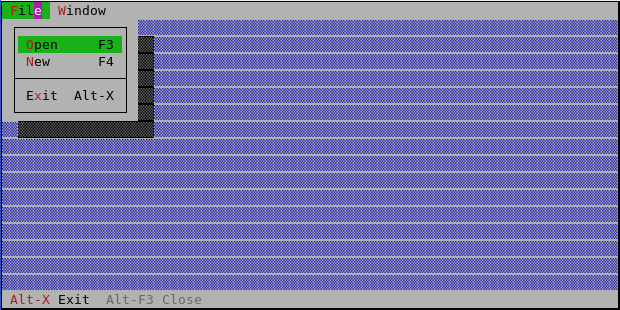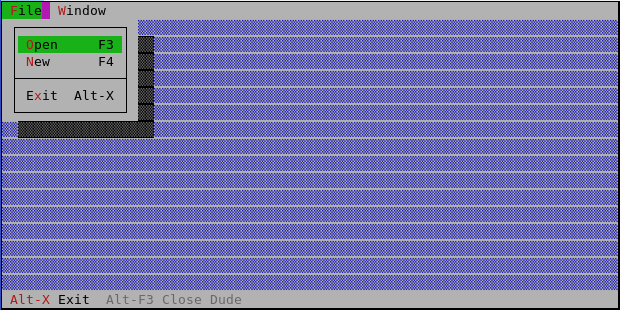Resurrecting Turbo Vision
Monday, Apr 23, 2018 |If you wrote software on a DOS system in the 80s or 90s, you probably used one of the Borland products, Turbo Pascal or Turbo C, with that beautiful, beautiful blue, mouse-enabled text-based user interface (TUI, if you will). Those IDEs were powered by a library called Turbo Vision (TV), which Borland documented and published for others to use. I loved it. While we all live in a GUI world and there are lots of libraries for building GUIS, I have for years now been dying to be able to use TV again, if for no other reason than hard core nostalgia. The problem being that I have used C in about 2 decades, and, to be honest, I’m not sure I’m too excited about writing even toy apps in the language. Dead end, right? Not so fast.
Enter, stage left: SWIG. SWIG, the Simplified Wrapper and Interface Generator, is a tool for building wrappers for libraries written in, say, C or C, for languages such as Python, PHP, and... Java. While it may not be the best option, it's an option, and I've been tinkering with it off and on for many, many moons now with the C version of the library open source by Borland long ago, before they were sold off and the Borland brand quietly disappeared. Tonight, I made great progress on it.
First, for those not familiar with Turbo Vision and don’t want to google, here’s a screen shot from one of the examples:

As you can see, it has a menu bar, a status line, and a desktop. It’s not demo’d here, but you can also create new windows, such as text editor windows for an IDE like Turbo Pascal and Turbo C++. The menu items in the menu bar and status line support keyboard activation (like we see in Windows) by pressing Alt plus the highlighted letter. You can also click on the item with your mouse.
Now having seen what the C++ demo looks like, let’s jump ahead a bit and look at the Java code. I won’t go into the SWIG interface file just yet, though I hope to write about that in detail at some point in the future. I’ll admit I do like to post rough sketches of things I’m working on (take my Jerkey post, for example) in the open source spirit of "release early, release often". This code, though, is seriously ugly and will likely see some major changes as I learn more about the tool throughout the project. At any rate, just assume that I have an interface file that works well enough for now, and here’s the Java code using the native library:
public class TurboVisionDemo extends TApplication {
public TurboVisionDemo() {
super();
}
@Override
public TStatusLine initStatusLine(TRect r) {
r.getA().setY(r.getB().getY() - 1);
return new TStatusLine(r, new TStatusDef(0, 0xFFFF)
.addItem(new TStatusItem("~Alt-X~ Exit", tvisionJNI.kbAltX_get(), tvisionJNI.cmQuit_get()))
.addItem(new TStatusItem("~Alt-F3~ Close Dude", tvisionJNI.kbAltF3_get(), tvisionJNI.cmClose_get())));
}
@Override
public TMenuBar initMenuBar(TRect r) {
r.getB().setY(r.getA().getY() + 1);
TSubMenu sub1 = new TSubMenu("~F~ile", kbAltF_get());
sub1.addItem(new TMenuItem("~O~pen", 200, kbF3_get(), hcNoContext_get(), "F3"))
.addItem(new TMenuItem("~N~ew", 201, kbF4_get(), hcNoContext_get(), "F4"))
.addItem(newLine())
.addItem(new TMenuItem("E~x~it", cmQuit_get(), cmQuit_get(), hcNoContext_get(), "Alt-X"));
TSubMenu sub2 = new TSubMenu("~W~indow", kbAltW_get());
sub2.addItem(new TMenuItem("~N~ext", cmNext_get(), kbF6_get(), hcNoContext_get(), "F6"))
.addItem(new TMenuItem("~Z~oom", cmZoom_get(), kbF5_get(), hcNoContext_get(), "F5"));
TMenuBar menuBar = new TMenuBar(r, sub1.addSubMenu(sub2));
return menuBar;
}
public static void main(String argv[]) {
TurboVisionDemo app = new TurboVisionDemo();
app.run();
}
}This program doesn’t do much, but it does recreate the menu and status bars from the demo that ships with the library. Here’s a screen shot of the app running:

Looks familiar, doesn’t it? I could have made things a bit easier for myself and just linked to the same image, but I didn’t because that didn’t seem honest. :) There is, though, one difference between the two images. Look at that status bar and you should see an extra menu item there, "Close Dude" (Don’t ask. I was probably tired one night :). Proof that I haven’t faked things. :P
As cool as that is (at least, I think it’s cool ;), it still doesn’t do much, and there’s much more to the library to wrap. Sometimes, the wrapping also comes with some changes to the C library itself to make it more easily consumed by, in my case, Java, and making those changes requires reaching back to my C days, and I’m finding those tools very rusty. I am, though, having a good time with it, and if all goes as planned, I hope to be able to use the same interface file and produce bindings for, say Python. When all is said and done, though, this may never be serious tool, but I’m having a good time learning while I wrap it, and the trip down memory lane is has been fun as well.
If you’d really like to the ugly state this thing is in at the moment, you can find the sources on Bitbucket. Just… be kind. :)
